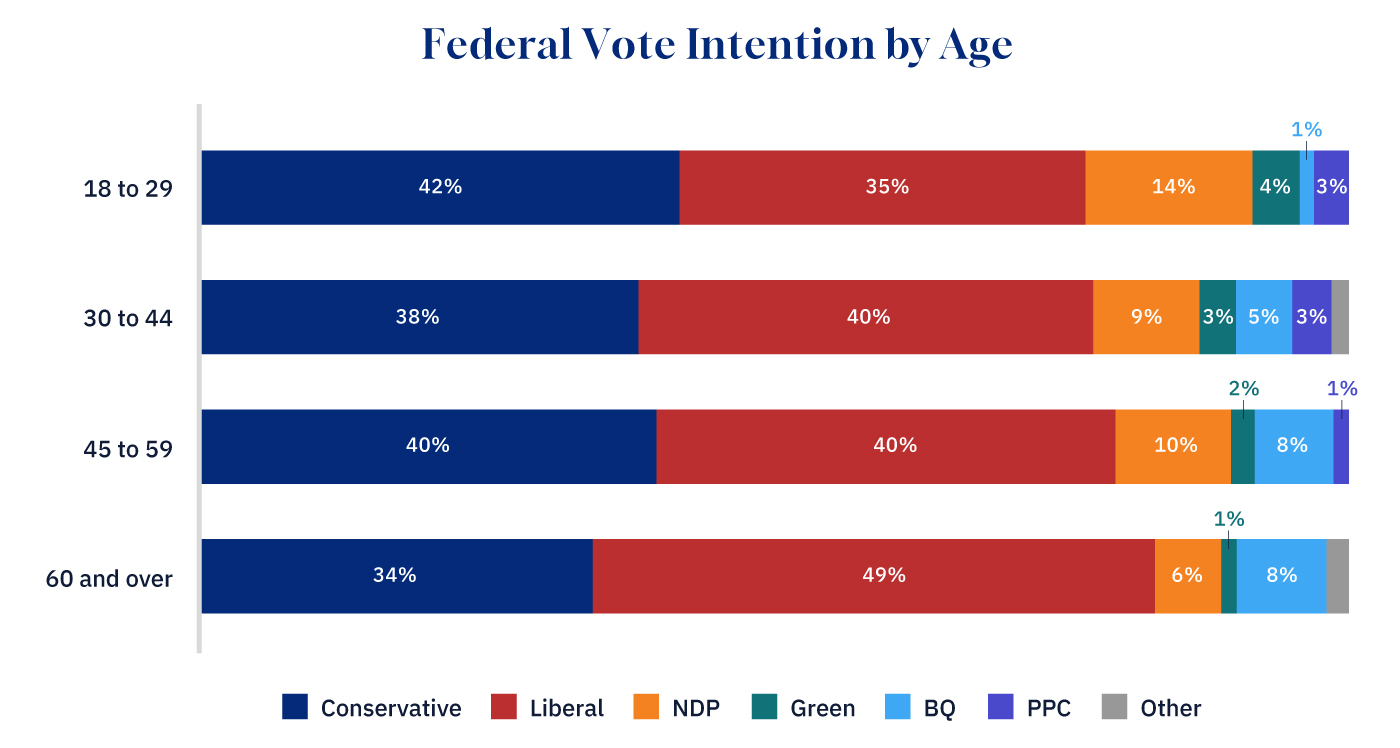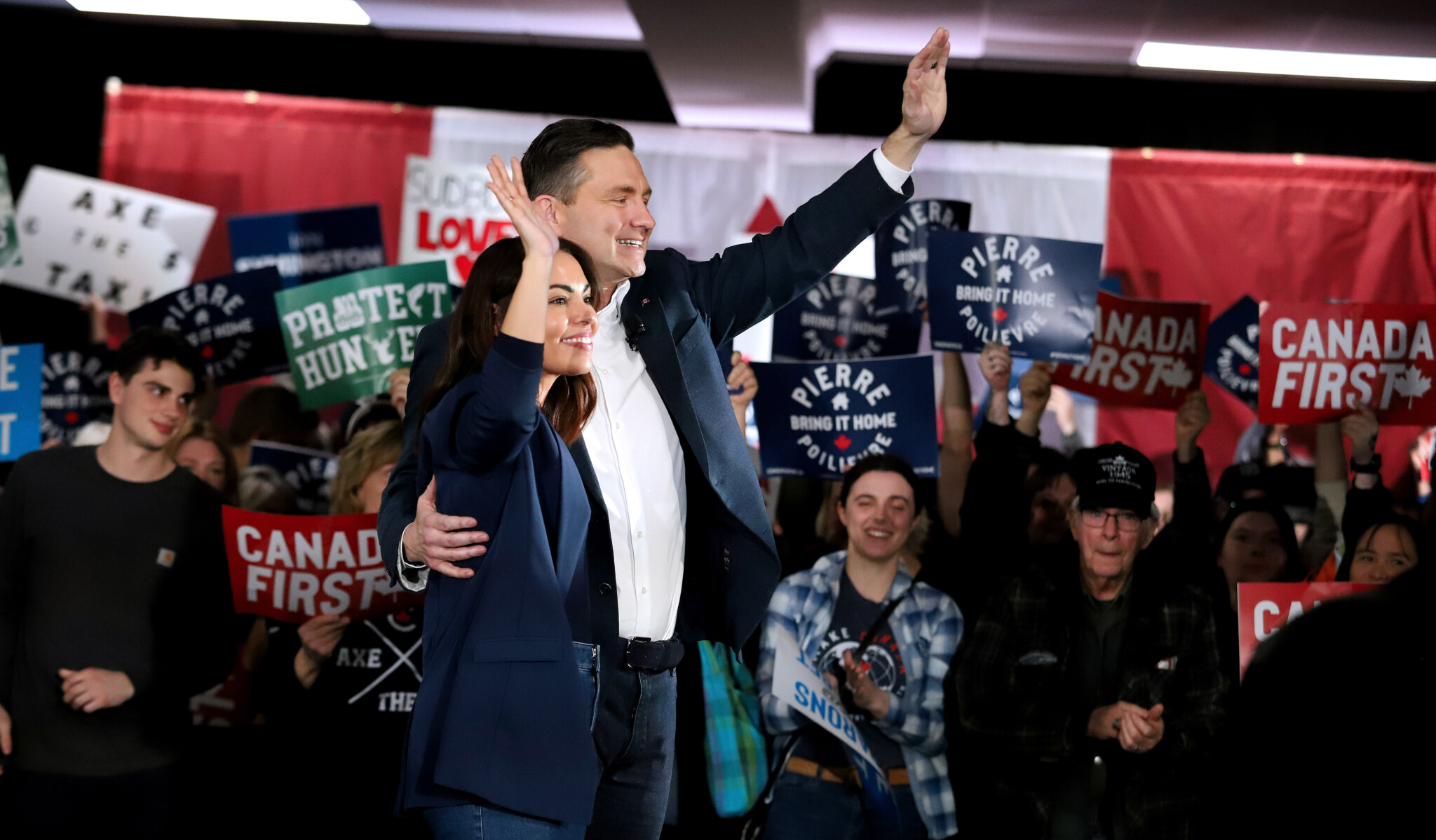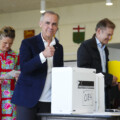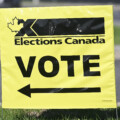Each election is called “the most important of our lifetime.” This time, though, it might actually be. Trump’s threat of tariffs and even annexation loom large, upending what was looking to be a guaranteed Conservative super-majority into a race that has shown to be far more competitive.
At the heart of this political shift is older Canadians who’ve disproportionately adopted an anti-American “elbows up” posture and see Pierre Poilievre as too akin to President Trump—despite comments that suggest that Trump would prefer Mark Carney. Given this demographic-driven dynamic, Poilievre’s chances hinge on a colossal youth turnout, with Gen Z proving to be one of the most supportive group of the Conservatives. It’s a seismic shift from 2015 when Justin Trudeau was elected largely on a wave of youth enthusiasm, but not a surprising one to anyone who’s been paying attention.

Graphic credit: Janice Nelson.
This election is occurring against a backdrop of real anxiety and pessimism among my cohort. Discussions about moving to the U.S for work or education are increasingly routine among my Gen Z peers. For those still here, a fourth Liberal victory may be enough to cause us to turn words into action.
In 2022, a net 42,000 more Canadians moved to the U.S., the largest surge in over a decade. A study of STEM graduates from three of Canada’s most competitive institutions (University of Toronto, University of Waterloo, and UBC) showed that within a decade of graduation, one in four work south of the border. And a University of Ottawa study found 64 percent of graduate students are likely to move abroad, while 50 percent of recent graduates already have or plan to.
Who can blame them? Young Canadians faced 14.2 percent unemployment last summer, the highest outside of the pandemic, since 2012, while the U.S. offers more opportunities and higher salaries. In the same University of Ottawa study, graduates who moved abroad reported an average salary of $113,000, compared to $67,000 for those who stayed but are intending to leave.
The Liberals cannot escape blame here. Real GDP per capita has declined for five straight quarters through mid-2024; now 3.6 percent smaller than in 2022. The U.S. was projected to produce nearly 50 percent more per person than Canada last year. Our labour productivity shrank by 1.8 percent in 2023, the worst decline in the entire OECD, and we’re projected to have the slowest per-capita GDP growth in the developed world over the next four decades. And our overall unemployment rate hovers around 5-6 percent, while the U.S. is at 3.5-4 percent. After a decade of Liberal promises, this is the reality: declining productivity, stagnating wages, and an economy falling further behind.
Then there’s the Liberals’ record of fiscal mismanagement. With a projected of at least $50 billion deficit this year, top talent faces combined federal-provincial tax rates exceeding 50 percent in many provinces, while the U.S. slashes corporate taxes, and several states have no income tax at all. Gen Z, already struggling to afford homes under the Liberals, will be forced to foot the bill. Housing now costs 10.8 times average earnings—$155,000 for an average mortgage, nearly double the median income of $87,000. How does Canada expect to retain talent when the economic deck is so stacked against us? Why fight for a country that hasn’t had our back when more promising opportunities lie elsewhere?
Canada’s brain drain is real, driven by policy that has stifled opportunity and made us vulnerable to geopolitical pressure. As more leave, Canada’s innovation capacity and tax base shrink, making it harder to finance the policies that drive competitiveness. It’s a vicious cycle, and Poilievre’s “lost Liberal decade” diagnosis resonates because my generation has been on the front line of its effects.
From public school in Edmonton to Harvard and Oxford, to Canada’s central bank and then the Bank of England, Carney is a prime example of how any Canadian child can and should shoot for the stars. In light of Canada’s immense challenges, it might seem excusable for older voters to shift to someone with his background and credentials.
But this election isn’t a heavyweight prize-fight between Carney and Poilievre. It’s Poilievre versus the lost Liberal decade, which Carney is all too eager to continue. If Carney is yearning to represent a fundamental change from the government that came before, then why was his leadership bid run by Trudeau’s top advisors, and with all but three of his short-lived cabinet drawn from Trudeau’s old ministers? How can he effectively make that case when he was an economic advisor to Trudeau since COVID-19? The same people who presided over this damning record are the ones vying to solve it. Three months ago, Canadians were ready to bury the Liberals. Why embrace them now when their new leader’s fingerprints and DNA are all over their record of failure?
The real solution to Trump’s economic and political threat isn’t “elbows up.” It’s a new economic plan that boost economic growth and supports the aspirations of younger Canadians. It’s exactly what Poilievre proposes.
Policies like repealing the carbon tax, eliminating the GST on new homes under $1.3 million, and converting 15 percent of federal buildings into affordable housing units are just peripheral. Poilievre’s going further by lowering the lowest federal income tax bracket from 15 to 12.75 percent or allowing individuals to defer capital gains if reinvested in Canadian businesses. His plan will stimulate a competitive economy that will improve young lives and keep the White House in check. Both business and union leaders are applauding.
Who else agrees? Carney! From tax cuts to GST relief to fiscal balance pledges, his platform is simply a cheap copy of Poilievre’s. But we’ve seen this horror flick before: the Liberals promise to eventually balance the budget, followed by a decade of bloat and more deficits and debt. Why would he be any different?That the Liberals’ platform pledges deficits and spending even beyond anything we saw during the Trudeau years is not a promising sign.
We cannot afford to ignore Canada’s fragilities. Older Canadians must grant us the same chance at success that they once enjoyed. Only the Conservatives are offering a plan to revitalize our country’s future, not just cement the status quo. This election cannot be about emotional responses to Trump. It’s about whether we reward systematic failure with a face-lift, or demand something more honest and accountable. Whether we accelerate the brain drain and cement a lost Liberal generation—or reverse the lost Liberal decade and keep younger Canadians, including those in my generation, here at home.
To our parents and grandparents: vote for Canada’s future. Vote for Gen Z. And that means voting for Poilievre come April 28th.









